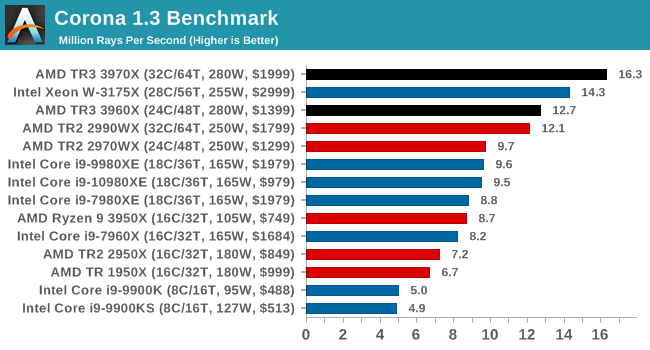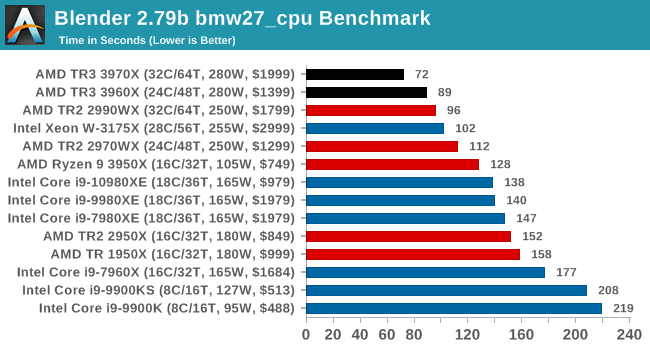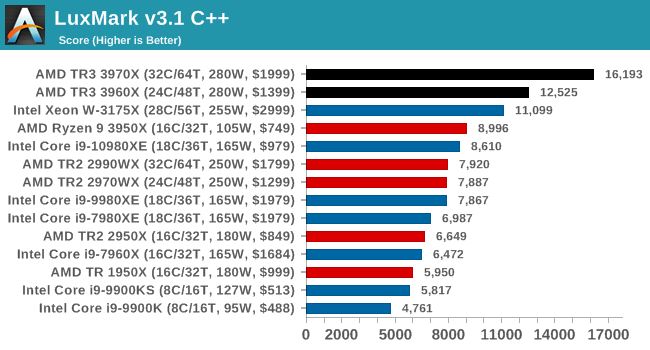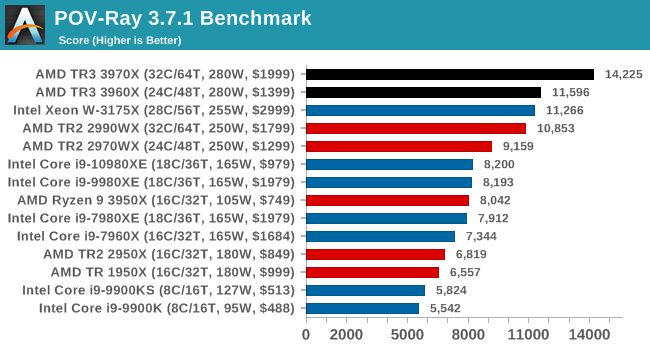The AMD Ryzen Threadripper 3960X and 3970X Review: 24 and 32 Cores on 7nm
by Dr. Ian Cutress, Andrei Frumusanu & Gavin Bonshor on November 25, 2019 9:05 AM ESTCPU Performance: Rendering Tests
Rendering is often a key target for processor workloads, lending itself to a professional environment. It comes in different formats as well, from 3D rendering through rasterization, such as games, or by ray tracing, and invokes the ability of the software to manage meshes, textures, collisions, aliasing, physics (in animations), and discarding unnecessary work. Most renderers offer CPU code paths, while a few use GPUs and select environments use FPGAs or dedicated ASICs. For big studios however, CPUs are still the hardware of choice.
All of our benchmark results can also be found in our benchmark engine, Bench.
Corona 1.3: Performance Render
An advanced performance based renderer for software such as 3ds Max and Cinema 4D, the Corona benchmark renders a generated scene as a standard under its 1.3 software version. Normally the GUI implementation of the benchmark shows the scene being built, and allows the user to upload the result as a ‘time to complete’.
We got in contact with the developer who gave us a command line version of the benchmark that does a direct output of results. Rather than reporting time, we report the average number of rays per second across six runs, as the performance scaling of a result per unit time is typically visually easier to understand.
The Corona benchmark website can be found at https://corona-renderer.com/benchmark

Being fully multithreaded, we see the order here follow core counts. That is except for the 32-core 2990WX sitting behind the 24-core 3960X, which goes to show how much extra performance is in the new TR generation.
Blender 2.79b: 3D Creation Suite
A high profile rendering tool, Blender is open-source allowing for massive amounts of configurability, and is used by a number of high-profile animation studios worldwide. The organization recently released a Blender benchmark package, a couple of weeks after we had narrowed our Blender test for our new suite, however their test can take over an hour. For our results, we run one of the sub-tests in that suite through the command line - a standard ‘bmw27’ scene in CPU only mode, and measure the time to complete the render.
Blender can be downloaded at https://www.blender.org/download/

We have new Threadripper records, with the 3970X almost getting to a minute to compute. Intel's nearest takes almost as long, but does only cost half as much. Again, the 3960X puts the 2990WX in its place.
LuxMark v3.1: LuxRender via Different Code Paths
As stated at the top, there are many different ways to process rendering data: CPU, GPU, Accelerator, and others. On top of that, there are many frameworks and APIs in which to program, depending on how the software will be used. LuxMark, a benchmark developed using the LuxRender engine, offers several different scenes and APIs.
In our test, we run the simple ‘Ball’ scene. This scene starts with a rough render and slowly improves the quality over two minutes, giving a final result in what is essentially an average ‘kilorays per second’.

Our LuxMark test again pushes both TR3 processors out in the lead.
POV-Ray 3.7.1: Ray Tracing
The Persistence of Vision ray tracing engine is another well-known benchmarking tool, which was in a state of relative hibernation until AMD released its Zen processors, to which suddenly both Intel and AMD were submitting code to the main branch of the open source project. For our test, we use the built-in benchmark for all-cores, called from the command line.
POV-Ray can be downloaded from http://www.povray.org/

More rendering, more wins for AMD. More losses for the 2990WX, even though on these tests it still beats the 10980XE quite easily.











245 Comments
View All Comments
melgross - Tuesday, November 26, 2019 - link
What you’re missing is that I’m talking about most users. The ones you mention are in very small numbers. There’s about a billion Windows machines out there, well under 1% need 16 or more cores. That still millions, but it’s not enough to move the market.What been one of the biggest problems involving pc sales the past year? Intel not producing enough chips. Not AMD. AMD is almost an afterthought. Most vendors and customers don’t want AND. Most pc users have never even heard of and. It’s why the are cheaper, and make little profit. They sell on price. And they’re trying to move in a market Intel isn’t very interested in—yet.
Xyler94 - Tuesday, November 26, 2019 - link
Most people just need their ARM powered cell phones these days, if you really want to get down to reality. light web browsing, posting on Facebook, sending an IM on messenger, potentially watching YouTube. All things that can be done off a cellphone. For those who need a bigger display, laptops are a good choice, but see little use outside of a few instances where a bigger screen is necessary.maxxbot - Tuesday, November 26, 2019 - link
And it's a continuously moving target too, just a few years ago people would say 8 cores is way more than necessary, now it's a baseline.mdriftmeyer - Tuesday, November 26, 2019 - link
Yes they do Mel. You just don't seem to know it. When Zen 3 get AVX 512 Apple has no more need of Intel, period. Mac Pro down to Macbook Air can be replaced w/ superior low power, higher performance per watt, lower priced CPUs to match RDNA 2.0 GPGPUs.xrror - Tuesday, November 26, 2019 - link
About the too much power... it might be that nobody is saying anything because if you fully load the processor with a workload where it draws it's full 300w.......it means that it's performing a workload that a few years prior would have required 4 separate machines at full tilt to match, and I'm pretty sure that 4 older gen HEDT rigs running full tilt is going to be drawing something significantly more than 300w overall in CPU power, let alone the rest of the rigs.
Korguz - Wednesday, November 27, 2019 - link
that is not what it means....beggerking@yahoo.com - Monday, November 25, 2019 - link
you forgot virtualization. now people can run virtualized environment for casual things such as file server, media server, backups, scheduler server, and even host their own websites.Dug - Monday, November 25, 2019 - link
You forgot the cost of virtualization if using Windows. They charge per core now, not per processor.Alistair - Tuesday, November 26, 2019 - link
The cost per core is a bit problem for AMD. Company just bought 3 x Epyc servers, and the much lower price was blunted by the per core licensing. Microsoft is effectively supporting Intel unintentionally... would rather they charge based on the MSRP of the CPU or something...Alistair - Tuesday, November 26, 2019 - link
big